If television programming reflects the society that produces and consumes it, then Islam’s increased presence on the small screen underscores the growing impact of — and fascination with — Muslims in the West. Three news items highlight this trend.
A Danish public television channel recently held a fashion competition to find Miss Headscarf 2008, a title eventually claimed by Iraqi-born 18-year-old Huda Falah, who noted that she had entered the contest to counter stereotypes and promote understanding among Denmark’s youth. However, a Muslim advocacy group in Copenhagen advised young adults not to participate:
“The whole point of the headscarf is that it’s a symbol of chastity,” said spokeswoman Bettina Meisner. “We don’t wish young women to expose themselves as objects.”
Brussels parliament member and councillor Nathalie Gilson asked what supervision Télé Bruxelles has over broadcasts. She mentioned that wearing a burqa is not permitted in Brussels. According to the general manager of Télé Bruxelles, Marc De Haan, it is not a burqa, but “somebody with a veil on the head and in front of the face.”
A leader of the Muslim group is seen defending to a local person the plan to turn the parish hall into a mosque. “It’s a pilot project,” he says, leading the man to exclaim wide-eyed, “You’re training pilots?!”
As always, broadcasters have the right to air what they believe will draw an audience — just as viewers have the right to change the channel.





